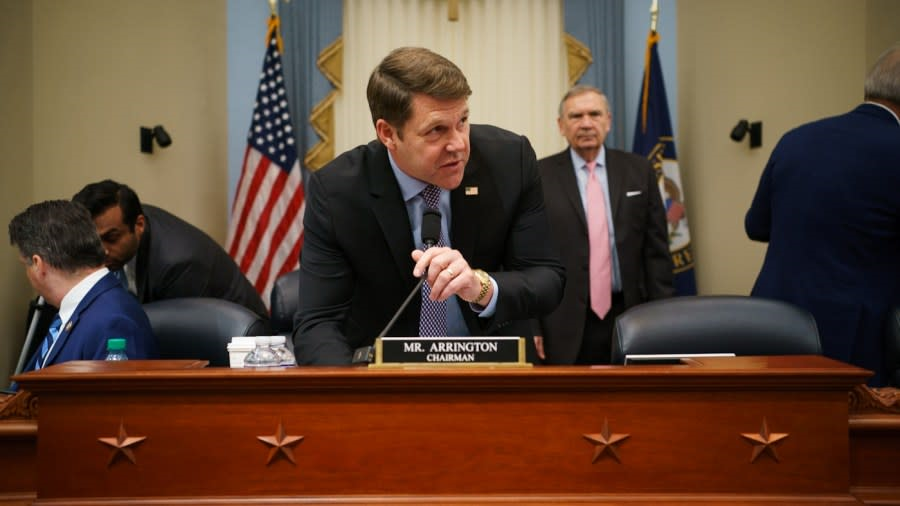
The House Budget Committee advanced a budget resolution after a marathon meeting Thursday, clearing the first hurdle in the GOP conference’s effort to pass President Trump’s legislative agenda.
The panel approved the budget resolution in a party-line 21-16 vote, sending it to the full chamber for consideration. It remains unclear when Speaker Mike Johnson (R-La.) plans to bring the measure to the floor; the House is out of session next week and is set to return to Washington on Feb. 24.
Passage of the budget resolution marks a significant step forward in the House GOP’s quest to enact Trump’s domestic policy priorities in one sprawling bill, a measure that would extend his 2017 tax cuts, appropriate more money for the border and pass energy policy. Republicans are looking to utilize the budget reconciliation process, which would allow the party to circumvent Democratic opposition in the Senate.
“This budget resolution provides the fiscal framework for what will be one of the most consequential pieces of legislation in modern history and the principal legislative vehicle for delivering on President Trump’s America First agenda,” House Budget Committee Chair Jodey Arrington (R-Texas) said in his opening statement of Thursday’s meeting.
The successful committee vote came after days of logjam in the chamber, with hard-line conservatives demanding deeper spending cuts, leadership blowing through a number of self-imposed deadlines and the conference cycling through several proposals before landing on the one that advanced Thursday.
The resolution outlines a $1.5 trillion floor for spending cuts across committees with a target of $2 trillion, a $4.5 trillion cap on the deficit impact of the Republicans’ plan to extend Trump’s 2017 tax cuts, and $300 billion in additional spending for the border and defense. It also increases the debt limit by $4 trillion.
The blueprint, however, was not an immediate triumph. A number of hard-line conservatives on the Budget Committee had withheld their support from the measure, requesting various commitments on spending cuts, the rollback of energy subsidies and the upcoming appropriations process, among other areas.
The breakthrough came Thursday morning, shortly before the meeting began, when conservatives and House GOP leadership struck an agreement on an amendment that appeased the hard-liners’ qualms. The committee approved that amendment during the markup in a party-line 21-16 vote — after voting down more than two dozen Democratic-led amendments protesting the resolution — setting the measure up for advancement.
Republicans also adopted an amendment to ensure the Regulations from the Executive in Need of Scrutiny Act is included in the final reconciliation bill. The legislation, which Republicans passed in June 2023, is intended to increase congressional authority over the federal rulemaking process. Rep. Ralph Norman (R-S.C.), a House Freedom Caucus member who sits on the Budget Committee, had expressed a desire for the bill to be included in the measure.
But several land mines remain in the path forward. The House must now pass the resolution on the House floor — which will be a heavy lift as GOP lawmakers grapple with a razor-thin majority. If all Democrats vote no, which is expected, Republicans will only be able to lose one vote and still clear the measure.
The lower chamber is also going to have to come to a compromise with the Senate, where the Budget Committee advanced its own, contrasting budget resolution this week. Senate Republicans are utilizing a two-track reconciliation strategy, while House lawmakers are forcing ahead with a single bill.
And once both chambers agree on a strategy, Republicans will have to write the Trump agenda legislation within the instructions laid out in the budget resolution, a process that has a history of being thorny.
The House Budget Committee cleared the budget resolution after an hours-long meeting where the group considered more than two dozen Democratic-led amendments that sought to strike or change several parts of the measure. They were all voted down, but the display served as a Democratic protest of the sprawling Trump agenda measure.
“Let’s be clear: This plan is a Republican betrayal of the middle class,” Rep. Brendan Boyle (Pa.), the top Democrat on the Budget Committee, said in his opening statement during the markup. “It does not support hard-working Americans, it undermines them. Instead of investing in working families, House Republicans have drafted a plan that takes from working Americans to give to their billionaire donors.”
The group did, however, approve a manager’s amendment that was the linchpin for securing enough support to advance the budget resolution. The language would allow Rep. Jodey Arrington (R-Texas), the chair of the Budget committee, to increase the cap on the deficit impact of the tax portion of the reconciliation package if additional spending cuts are made in other areas.
It would also give teeth to a $2 trillion deficit reduction target outlined in the bill that was key for fiscal hawks.
For example, with the deficit reduction floor set at $1.5 trillion and a target of $2 trillion, if committees find $2.5 trillion in reductions, Arrington can allow the Ways and Means Committee to design policies that raise its deficit increase allowance from $4.5 trillion to $5 trillion — enabling the committee more flexibility to address Trump’s demands for tax cuts.
Importantly, the amendment would also require the Budget Committee chair to lower deficit increase allowances for the tax portion if that $2 trillion target is not reached, meaning the allowance for tax cuts and other priorities would be curtailed.
Budget hawks, including House Freedom Caucus Chair Andy Harris (R-Md.), lauded the language.
“This is it. We declare victory,” Harris said. “I mean, we have a bill that we believe that it had to be done rapidly to get the president the border funding as soon as possible. We believe it had that meaningful deficit reduction, and we believe it had to be able to advance the president’s tax policy. It all happens here.”


